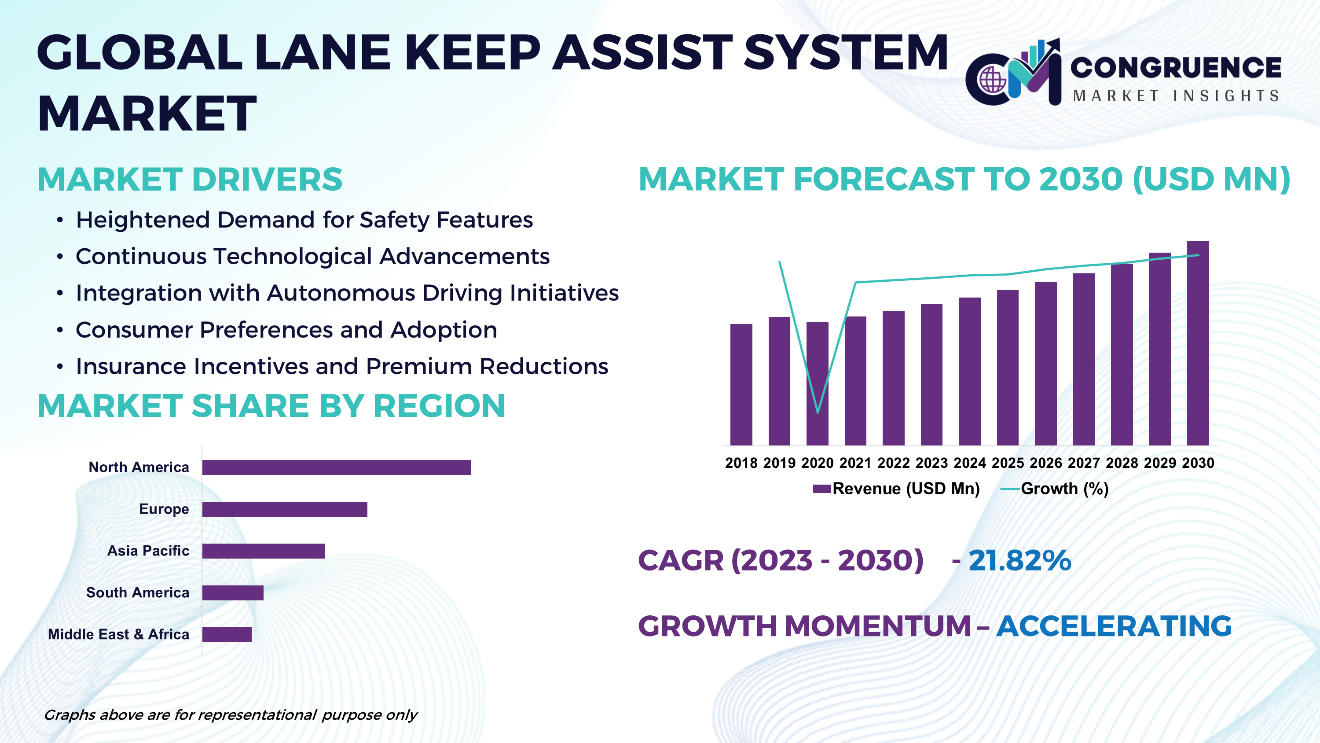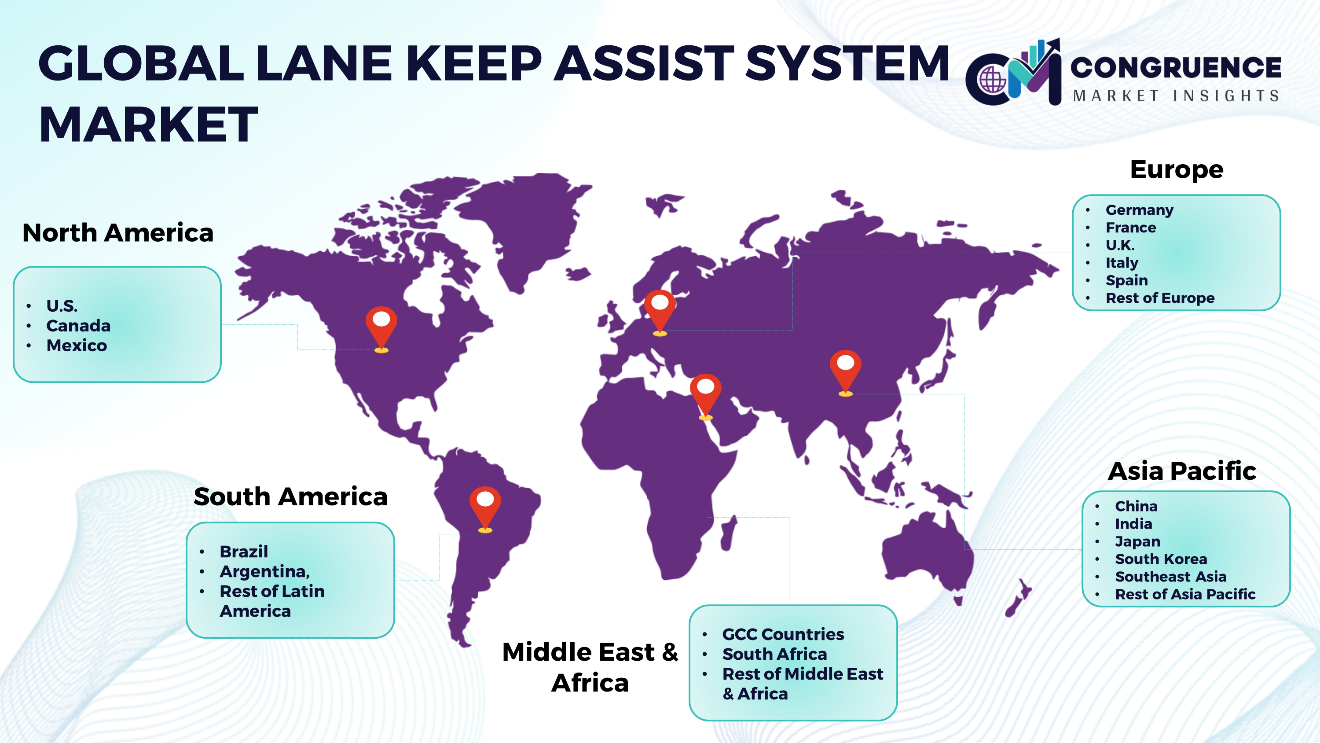Reports
The Global Lane Keep Assist System Market is expected to expand at a CAGR of 21.82% between 2023 and 2030. The Lane Keep Assist System (LKAS) stands as a significant advancement in automotive safety technology, aimed at mitigating the risks associated with lane departure incidents. Its significance lies in its ability to enhance driver awareness and vehicle control, thereby reducing the occurrence of accidents and bolstering overall road safety. Integration with Industry 4.0 frameworks has further elevated its functionalities, facilitating real-time data processing, predictive analytics, and seamless communication with other vehicle systems. Additionally, its incorporation of automotive communication protocols enhances interoperability with neighboring vehicles and infrastructure, fostering collaborative safety measures and enabling autonomous driving capabilities. Within the market landscape, the Lane Keep Assist System emerges as a pivotal component of advanced driver assistance systems (ADAS), appealing to a discerning consumer demographic that prioritizes safety and convenience features in modern automobiles.

Lane Keep Assist System Market Major Driving Forces
Heightened Demand for Safety Features: Increasing consumer cognizance and preference for safety technologies in automobiles, fueled by a commitment to augment both driver and passenger safety while curbing collision risks.
Continuous Technological Advancements: Ongoing advancements in sensor technology, machine learning algorithms, and artificial intelligence underpin the refinement of lane keep assist systems, amplifying their precision and reliability.
Integration with Autonomous Driving Initiatives: The seamless integration of lane keep assist systems as integral facets of autonomous driving endeavors propels the evolution and acceptance of semi-autonomous and autonomous vehicle models.
Consumer Preferences and Adoption: Growing consumer inclination toward vehicles equipped with sophisticated driver assistance systems, including lane keep assist, underscores their increasing accessibility and affordability.
Insurance Incentives and Premium Reductions: Incentive schemes from insurance entities, entailing premium reductions for vehicles furnished with advanced safety features such as lane keep assist, serve to incentivize consumer adoption and spur market expansion.
Lane Keep Assist System Market Key Opportunities
Integration with Autonomous Vehicles: Expanding the incorporation of LKAS into autonomous vehicle technologies to propel the advancement and widespread adoption of fully autonomous driving systems.
Integration with Fleet Management Solutions: Prospects for integrating LKAS with fleet management systems for commercial vehicles, enhancing driver safety and minimizing accident risks in fleet operations.
Aftermarket Installation Services: The potential for aftermarket installation services for LKAS in existing vehicle fleets, offering retrofit solutions to bolster vehicle safety and ensure compliance with regulatory standards.
Lane Keep Assist System Market Key Trends
· The LKAS integration into autonomous driving systems escalates as automotive manufacturers strive for heightened autonomy levels, such as Level 2 and Level 3.
· Persistent advancements in sensor technology, encompassing cameras, radar, and LIDAR, bolster the accuracy and reliability of LKAS, enabling enhanced detection and response to lane-keeping scenarios.
· Increased adoption of machine learning algorithms enhances LKAS performance, enabling systems to glean insights from real-world driving data and adapt to diverse road and weather conditions.
· Escalating regulatory mandates for vehicle safety features, including lane keep assist, notably in regions like Europe and North America, propel the integration of LKAS into new vehicle models.
· Expanded integration of LKAS with other advanced driver assistance systems (ADAS) features, such as adaptive cruise control and automatic emergency braking, delivers a comprehensive safety suite in vehicles.
· Heightened emphasis on driver monitoring systems within LKAS ensures driver attentiveness and engagement, mitigating concerns regarding reliance on automated driving features.
· Development of more intuitive and user-friendly interfaces for LKAS, comprising visual and auditory alerts, aims to enhance driver comprehension and interaction with the system.

Market Competition Landscape
In the realm of lane keep assist systems, the competitive arena is characterized by vigorous competition among industry stakeholders seeking market leadership. Key determinants driving this competition include product innovation, technological advancements, pricing strategies, and initiatives to penetrate target markets. Furthermore, adherence to regulatory frameworks, dedication to superior customer service, and cultivation of strategic alliances play instrumental roles in shaping competitive positioning within the market landscape.
Key players in the global Lane Keep Assist System market implement various organic and inorganic strategies to strengthen and improve their market positioning. Prominent players in the market include:
· Robert Bosch GmbH
· Continental AG
· Denso Corporation
· ZF Friedrichshafen AG
· Valeo
· Aptiv
· Magna International Inc.
· Autoliv
· Mobileye
· NVIDIA Corporation
· Hyundai Mobis
· Hitachi Astemo Americas, Inc.
· HELLA GmbH & Co. KGaA
· AISIN Corporation
· HL Mando Corp.
· HARMAN International
|
Report Attribute/Metric |
Details |
|
Base Year |
2022 |
|
Forecast Period |
2023 – 2030 |
|
Historical Data |
2018 to 2022 |
|
Forecast Unit |
Value (US$ Mn) |
|
Key Report Deliverable |
Revenue Forecast, Growth Trends, Market Dynamics, Segmental Overview, Regional and Country-wise Analysis, Competition Landscape |
|
Segments Covered |
· By Technology (Radar-based, Sensor-fusion based, LiDAR-based and Camera-based) · By Application (Safety Enhancement, Driver Assistance, Advanced Driver Assistance Systems (ADAS) integration, and Autonomous Driving) · By Vehicle Type (Passenger Vehicle, and Commercial Vehicle) · By Sales Channel (OEM (Original Equipment Manufacturer) sales and Aftermarket) |
|
Geographies Covered |
North America: U.S., Canada and Mexico Europe: Germany, France, U.K., Italy, Spain, and Rest of Europe Asia Pacific: China, India, Japan, South Korea, Southeast Asia, and Rest of Asia Pacific South America: Brazil, Argentina, and Rest of Latin America Middle East & Africa: GCC Countries, South Africa, and Rest of Middle East & Africa |
|
Key Players Analyzed |
Robert Bosch GmbH, Continental AG, Denso Corporation, ZF Friedrichshafen AG, Valeo, Aptiv, Magna International Inc., Autoliv, Mobileye, NVIDIA Corporation, Hyundai Mobis, Hitachi Astemo Americas, Inc., HELLA GmbH & Co. KGaA, AISIN Corporation, HL Mando Corp., HARMAN International |
|
Customization & Pricing |
Available on Request (10% Customization is Free) |
